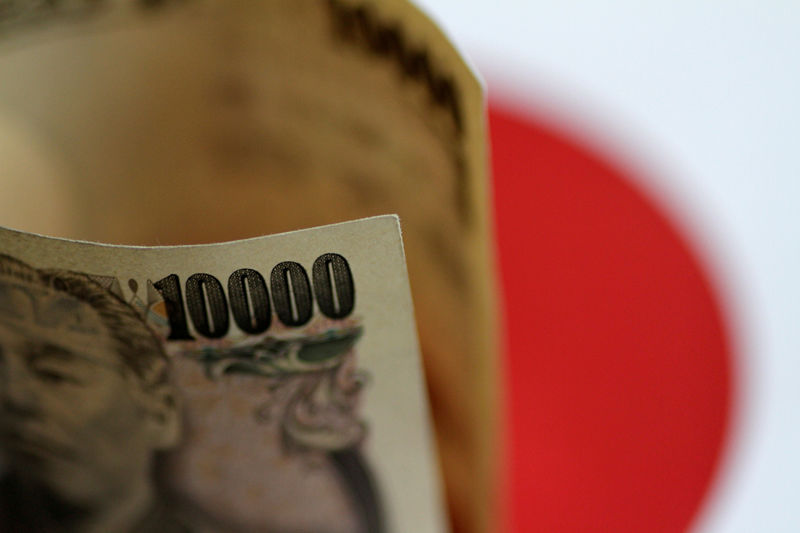Asia FX rattled by hot US inflation, Japanese yen weakens past 150 By Investing.com
[ad_1]

© Reuters.
Investing.com– Most Asian currencies nursed steep losses on Wednesday, while the dollar hovered near three-month highs after stronger-than-expected U.S. inflation data brewed more fears that the Federal Reserve will keep interest rates higher for longer.
The was the worst-hit by this trade, as recent dovish signals from the Bank of Japan kept traders largely averse towards the currency. The yen fell past the 150 level to the dollar for the first time since late-November, and was the worst-performing Asian currency this week.
A top-ranking BOJ official said that while the bank will begin raising interest rates from ultra-low levels this year, it will likely do so at a slow pace, heralding limited tightening in the ultra-loose monetary conditions that have weighed on the yen in recent months.
But a key point of pressure on the yen was expectations of higher for longer U.S. interest rates, especially after Tuesday’s consumer price index (CPI) print.
Dollar at 3-mth high as hot CPI batters rate cut bets
The and both fell about 0.1% in Asian trade, but remained squarely in sight of a three-month high.
The greenback shot up in overnight trade after showed inflation remained stickier than expected in January. The reading gave more credence to recent warnings from Fed officials that high inflation will see the bank keep interest rates steady for longer.
The reading also saw traders scale back bets on early rate cuts even further. The showed traders pricing in a 63.5% chance that the Fed will keep rates between 5.25% and 5.5% in May, and will only enact a 0.25% cut in June, of which traders were pricing in a 51% chance.
Higher-for-longer U.S. rates bode poorly for risk-heavy, high-yielding Asian currencies, as the gap between risky and low-risk yields narrows. U.S. Treasury yields also shot up after Tuesday’s inflation reading.
Broader Asian currencies were flat on Wednesday after clocking steep overnight losses. The rose 0.1% after sinking to a three-month low in the prior session.
The rose 0.2% after clocking its worst intraday loss in nearly a month, while the hovered around a three-month low.
The was static in offshore trade, but was within sight of a three-month low. Domestic Chinese markets were closed for a week-long Lunar New Year holiday.
The moved little on Wednesday, but weakened comfortably past the 83 level once again. The rupee was also in sight of a record low hit in 2023.
[ad_2]
Source link

© Reuters.
Investing.com– Most Asian currencies nursed steep losses on Wednesday, while the dollar hovered near three-month highs after stronger-than-expected U.S. inflation data brewed more fears that the Federal Reserve will keep interest rates higher for longer.
The was the worst-hit by this trade, as recent dovish signals from the Bank of Japan kept traders largely averse towards the currency. The yen fell past the 150 level to the dollar for the first time since late-November, and was the worst-performing Asian currency this week.
A top-ranking BOJ official said that while the bank will begin raising interest rates from ultra-low levels this year, it will likely do so at a slow pace, heralding limited tightening in the ultra-loose monetary conditions that have weighed on the yen in recent months.
But a key point of pressure on the yen was expectations of higher for longer U.S. interest rates, especially after Tuesday’s consumer price index (CPI) print.
Dollar at 3-mth high as hot CPI batters rate cut bets
The and both fell about 0.1% in Asian trade, but remained squarely in sight of a three-month high.
The greenback shot up in overnight trade after showed inflation remained stickier than expected in January. The reading gave more credence to recent warnings from Fed officials that high inflation will see the bank keep interest rates steady for longer.
The reading also saw traders scale back bets on early rate cuts even further. The showed traders pricing in a 63.5% chance that the Fed will keep rates between 5.25% and 5.5% in May, and will only enact a 0.25% cut in June, of which traders were pricing in a 51% chance.
Higher-for-longer U.S. rates bode poorly for risk-heavy, high-yielding Asian currencies, as the gap between risky and low-risk yields narrows. U.S. Treasury yields also shot up after Tuesday’s inflation reading.
Broader Asian currencies were flat on Wednesday after clocking steep overnight losses. The rose 0.1% after sinking to a three-month low in the prior session.
The rose 0.2% after clocking its worst intraday loss in nearly a month, while the hovered around a three-month low.
The was static in offshore trade, but was within sight of a three-month low. Domestic Chinese markets were closed for a week-long Lunar New Year holiday.
The moved little on Wednesday, but weakened comfortably past the 83 level once again. The rupee was also in sight of a record low hit in 2023.